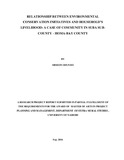| dc.description.abstract | Environmental degradation and destruction is a rising concern both locally and globally. This is in
view of the role of the environment on earth’s biogeochemical systems and a source of essential
ecosystem services to human wellbeing as well as its role in controlling the green house gas
effects. It is based on this argument that the study aimed at establishing the relationship between
environmental conservation initiatives and household’s livelihood in Suba Sub-County, Homa-Bay
County. Previous studies indicated that very little or no attention had been focused on the
relationship between environmental conservation initiatives and livelihoods of the rural
community. Research objectives included: to determine the relationship between promoting Agroforestry
as an environmental conservation initiative and Livelihood, to establish the relationship
between environmental education program as an environmental conservation initiative and
livelihood, to establish the relationship between environmental research and technology as an
environmental conservation initiative and livelihood of the community in Suba Sub-County, to
determine the relationship between promoting ecotourism as an environmental conservation
initiative and livelihood of the community in Suba Sub-County and to establish the relationship
between the combined environmental conservation initiatives and livelihood of the community in
Suba Sub-County. The study adopted descriptive survey design where both quantitative and
qualitative data were collected using questionnaires from a total of 375 adult respondents
representing randomly selected households. Random sampling in this case took the multi-stage
random sampling process to be able to identify the actual study area. Quantitative data was
analyzed using both descriptive and inferential statistics where Pearson-Product Moment
Correlation and regression modeling were applied to be able to establish the level of relationships
between environmental conservation initiatives and the livelihood of the community in Suba Sub-
County. Hypotheses of the study were tested using Chi-Square P-value. Inferential statistics were
applied purposefully to enable generalization of the results from the sample to the population. The
study established that there was a significant relationship between; promoting agro-forestry and
household livelihood with a correlation coefficient of 0.106, environmental education program and
household livelihood with a correlation coefficient of 0.270 and environmental research and
technology and household livelihood with a correlation coefficient of 0.161. Researcher therefore
concluded that there was a significant but weak relationship between environmental conservation
initiatives and household livelihood as the correlation coefficient tended towards 0.00. This study
recommends increased efforts on extension services, adjustments in approaches applied to
environmental education among the local communities and extensive mobilization and guidance of
the community based on best researched technology applications. This study suggests that further
studies can be conducted to investigate opportunities and potentiality of ecotourism, impact of
agro-forestry on livelihood and level of adoption of indigenous trees species in farms among
community in Suba Sub-County. | en_US |

